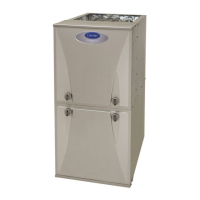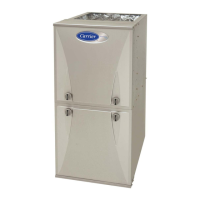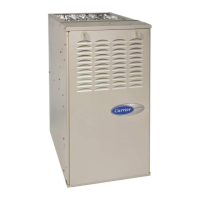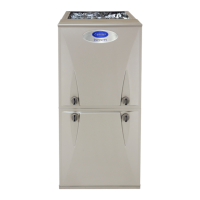PG92MSA: Installation, Start-up, Operating and Service and Maintenance Instructions
Manufacturer reserves the right to change, at any time, specifications and designs without notice and without obligations.
10
L12F012
Fig. 6 – Air for Combustion, Ventilation, and Dilution for Outdoors
L12F013
Fig. 7 – Air for Combustion, Ventilation, and Dilution from Indoors
3. ONE OUTDOOR OPENING requires:
a. 1 sq. in. (645 sq. mm) of free area per 3,000 BTUh (734
mm2/kW) for combined input of all gas appliances in the space
per Fig. 6 and Table 4.
b. Not less than the sum of the areas of all vent connectors in the
space.
The opening shall commence within 12 in. (300 mm) of the ceiling.
Appliances in the space shall have clearances of at least 1 in. (25 mm)
from the sides and back and 6 in. (150 mm) from the front. The opening
shall directly communicate with the outdoors or shall communicate
through a vertical or horizontal duct to the outdoors or spaces (crawl or
attic) that freely communicate with the outdoors.
Indoor Combustion Air NFPA & AGA
Standard and Known-Air-Infiltration Rate Methods
Indoor air is permitted for combustion, ventilation, and dilution, if the
Standard or Known-Air-Infiltration Method is used.
Standard Method
1. The space has no less volume than 50 cubic feet per 1,000 BTUh of
the maximum input ratings for all gas appliances installed in the
space and
2. The air infiltration rate is not known to be less than 0.40 air changes
per hour (ACH).
The Known Air Infiltration Rate Method shall be used, if the infiltration
rate is known to be:
1. Less than 0.40 ACH and
2. Equal to or greater than 0.10 ACH
Infiltration rates greater than 0.60 ACH shall not be used. The minimum
required volume of the space varies with the number of ACH and shall
be determined per Table 5 or Equations 1 and 2. Determine the minimum
required volume for each appliance in the space and add the volumes
together to get the total minimum required volume for the space.
Table 5 - Minimum Space Volumes were determined by using the
following equations from the current edition of the National Fuel Gas
Code ANSI Z223.1/NFPA 54, 9.3.2.2:
1. For other than fan-assisted appliances, such as a draft
hood-equipped water heater:
A04002
2. For fan-assisted appliances such as this furnace:
A04003
If:
I
other = combined input of all other than fan-assisted appliances in
BTUh/hr
I
fan = combined input of all fan-assisted appliances in BTUh/hr
ACH = air changes per hour (ACH shall not exceed 0.60.)
The following requirements apply to the Standard Method and to the
Known Air Infiltration Rate Method.
1. Adjoining rooms can be considered part of a space if:
a. There are no closeable doors between rooms.
b. Combining spaces on same floor level. Each opening shall have
free area of at least 1 in.2/1,000 BTUh (2,000 mm2/kW) of the
total input rating of all gas appliances in the space, but not less
than 100 in.2 (0.06 m2). One opening shall commence within 12
in. (300 mm) of the ceiling and the second opening shall
commence within 12 in. (300 mm) of the floor. The minimum
dimension of air openings shall be at least 3 in. (80 mm). See
Fig. 7.
c. Combining space on different floor levels. The volumes of
spaces on different floor levels shall be considered as
0 LQLPXPRSHQLQJVL]HLVVTLQVTPPZLWK
PLQLPXPGLPHQVLRQVRI‐LQPP
0LQLPXPRI‐LQPPZKHQW\SH‐%YHQWLVXVHG
WARNING
!
CARBON MONOXIDE POISONING HAZARD
Failure to follow this warning could result in personal injury or death.
Many homes require air to be supplied from outdoors for furnace
combustion, ventilation, and dilution of flue gases.
The furnace combustion air supply must be provided in accordance
with this instruction manual.
Volume
Other
=
21ft
3
ACH
I
other
1000 Btu/hr
Volume
Fan
=
15ft
3
ACH
I
fan
1000 Btu/hr

